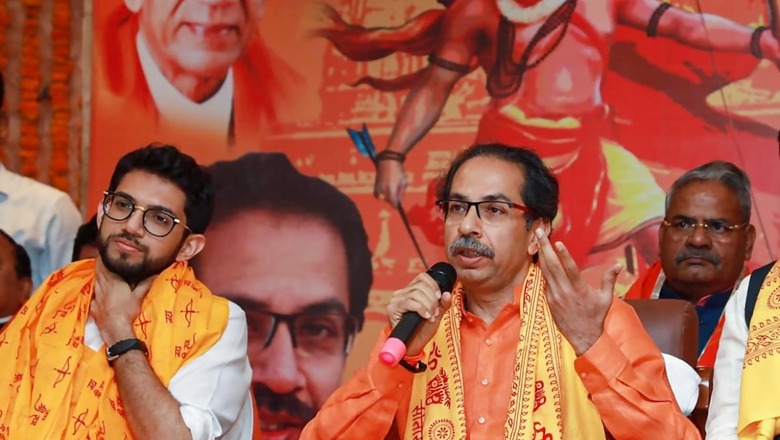
views
A Shiv Sena leader who was in Ayodhya on December 6, 1992 when the Babri Masjid was razed by frenzied kar sevaks, once narrated an anecdote which revealed the talismanic appeal that the late Sena supremo Bal Thackeray had over the adherents of aggressive Hindutva.
According to the Shiv Sena leader, there were rumours that the party chief would make a dramatic entry in Ayodhya on the fateful day when the domes of the Mughal era mosque were being felled. From time to time, including when the distant whir of a helicopter was heard, kar sevaks would shout ‘Balaji (Bal Thackeray) aa gaye’, claimed the Sena leader, who later became the mayor of Mumbai.
However, despite Bal Thackeray’s charisma and image as a hardline Hindutva mascot, especially during the days of the Ram Temple movement, the Shiv Sena was unable to break substantial ground outside its home state of Maharashtra even during his lifetime.
This lack of success at the national level underlines the Sena’s predicament while managing the contradictions between its nativist, pro-Marathi manoos position in Maharashtra and its subsequent shift to Hindutva. The only time that a Shiv Sena nominee has been elected to a state assembly outside Maharashtra was Pavan Kumar Pandey from Uttar Pradesh’s Akbarpur in 1991 at the zenith of the Ram Mandir movement.
Now, as the Shiv Sena prepares to contest the Bihar state assembly elections, there is a question mark over whether it will manage to overcome this jinx, especially after the Nitish Kumar government in the state ran a campaign seeking “justice” for Bollywood actor Sushant Singh Rajput after his death in Mumbai.
This campaign by the JDU-BJP regime led to it being at odds with the Maharashtra Vikas Aghadi (MVA) government under Sena president Uddhav Thackeray.
In 2015, the Shiv Sena had contested from over 70 seats for the Bihar assembly and secured about 2.11 lakh votes. Sena leaders claim that this time, they are likely to get success due to the humanitarian assistance provided by party cadre and the Maharashtra government to stranded migrant labourers in Maharashtra during the lockdown.
The Shiv Sena was born in 1966 as the culmination of an agenda that sought justice for the Marathi-speakers in Mumbai and nearby areas who had to compete with “outsiders” for access to jobs and resources. But it came to terms with changing demographic and economic realities by formally making a shift to hardline Hindutva in the 1980s.
While reaching out to the growing numbers of non-Maharashtrians, especially Hindi speakers and mercantile communities like Gujaratis, Marwaris and Jains, in Mumbai and the larger Mumbai metropolitan region, Hindutva helped the Shiv Sena expand beyond its traditional catchments.
However, despite its broad social base in Maharashtra, the Shiv Sena’s systematic “othering” of linguistic and social groups like South Indians, Muslims and Hindi speakers ensured that any inroads in these sections were only incremental and expedient.
Since accepting Hindutva in a cosmopolitan city like Mumbai where Maharashtrians are the largest linguistic minority, and not the majority, implies an incongruence with its core nativist agenda, this outreach came at the cost of its Marathi vote-base. This had also led to the emergence of a challenger in the form of the rival Raj Thackeray-led Maharashtra Navnirman Sena (MNS).
With the Shiv Sena allying with “secular” parties like the Congress and the Nationalist Congress Party (NCP) to form its government in Maharashtra last year by snapping ties with saffron ally BJP, its balancing act in the Marathi vs Hindutva conundrum will be more obvious.
Shiv Sena leaders admit that they have been unable to shed the tag of being a provincial party from Maharashtra, which affects its prospects at the national level. This, along with the anti-migrant stance of the Sena, restricts its ability to mobilise public support in northern states. Incidentally, the Shiv Sena has also been unable to break ground in the coastal state of Goa, which shares a linguistic, cultural and economic affinity with Maharashtra.
This can be attributed to the inability of the Sena leadership to establish a party organization in states outside Maharashtra and build the organization ground-up since the days of the Ram Janmabhoomi movement. In Maharashtra, it was the Sena rather than the BJP which had taken charge of the movement largely due to its Bahujan social base.
Though the Shiv Sena deputed leaders like Satish Pradhan, Chandrakant Khaire, Sanjay Nirupam and Sanjay Raut to handle party affairs in other states, sources admit that the habit of getting leaders to paratroop from Mumbai caused its own set of problems. It prevented the organisation from striking at the roots organically even in regions where it had potential to grow. Now, the Shiv Sena’s charge in North India is being led by Vinay Shukla ‘Sir’, who is Yuva Sena chief and Maharashtra environment minister Aaditya Thackeray’s Hindi tutor.
At times, decisions on allowing candidates to contest as Shiv Sena nominees were influenced by motives like eating into the vote share of other parties. Though the Shiv Sena has managed to put up a good show in seats in states like Gujarat, leaders admit that this can be attributed to the vote-catching abilities of the candidates and local factors rather than the larger appeal of the party.
Sena leaders claim that their pan-India expansion was hindered by their almost three-decade alliance with the BJP, wherein the party took the role of a senior partner in Maharashtra, leaving national level politics for its ally.
As the Shiv Sena tries to create a cocktail of Hindutva with local issues for success in other states, this may be hobbled by the stronger pro-Hindutva appeal of the BJP’s star politicians like Prime Minister Narendra Modi, home minister Amit Shah and Uttar Pradesh chief minister Yogi Adityanath. For when an original is available, why would anyone prefer a photocopy or imitation?
Read all the Latest News and Breaking News here




















Comments
0 comment